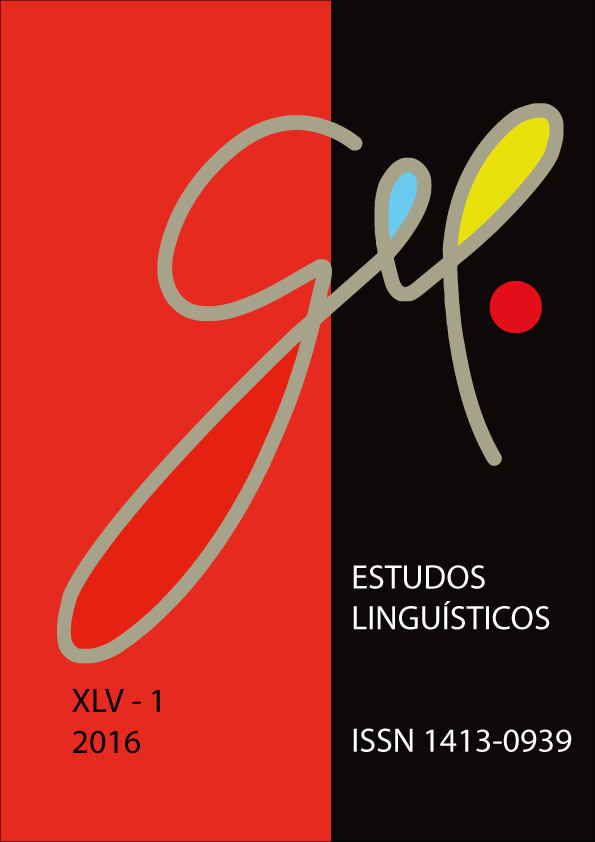Línguas naturais consideradas como sistemas complexos adaptativos
DOI:
https://doi.org/10.21165/el.v45i1.787Palavras-chave:
sistemas complexos, linguística, adaptação, variação sociolinguística.Resumo
Certas propriedades básicas de sistemas complexos são comparadas com as de línguas naturais. Argumenta-se que as línguas são compostas de unidades que interagem e compõem um todo em funcionamento com as propriedades de estrutura de rede, controle descentralizado, emergência, causalidade recíproca, estado longe de equilíbrio e processos de feedback positivo e negativo. Também é discutida a possibilidade de que as línguas têm a propriedade de adaptabilidade. O problema principal em definir a adaptabilidade da linguagem é tido como o papel desempenhado pela variação linguística individual na manutenção de uma estabilidade e capacidade de mudança da linguagem. Para concluir, argumenta-se que considerar as línguas naturais como sistemas adaptativos complexos serve como base para hipóteses que podem ser modeladas e testadas empiricamente, e que a abordagem de sistemas complexos pode trazer uma unidade e coerência para a compreensão de diversos fenômenos linguísticos.Downloads
Referências
ARONOFF, M.; MEIR, I.; PADDEN, C.; SANDLER, W. Open peer commentary: lan-guage is shaped by the body. Behavioral and brain sciences, v. 31, n. 5, p. 509-511, 2008.
BECKNER, C.; BLYTHE, R.; BYBEE, J.; CHRISTIANSEN, M. H.; CROFT, W.; ELLIS, N. C.; HOLLAND, J.; KE, J.; LARSEN-FREEMAN, D.; SCHOENEMANN, T. Language is a complex adaptive system: position paper. Language Learning, v. 59, s. 1, p. 1-26, 2009.
BERNÁRDEZ, E. Collective cognition and individual activity: variation, language and culture. In: FRANK, R. M. et al. (eds.). Body, Language and Mind. v. 2. Berlin: Mouton de Gruyter, 2008. p. 137-166.
BOECKX, C. Elementary Syntactic Structures. Cambridge: Cambridge University, 2014. 222 p.
CHOMSKY, N. Knowledge of Language: Its Nature, Origin, and Use. New York: Praeger, 1986. 307 p.
CHRISTIANSEN, M. H.; CHATER, N. Language as shaped by the brain. Behavioral and brain sciences, v. 31, n. 5, p. 489-509, 2008.
CROFT, W. Grammar: functional approaches. n. d. Available at: <http://www.unm.edu/~wcroft/Papers/Functionalism-IESBS2ed.pdf>. Accessed on: 4 Oct. 2015.
CROFT, W. Explaining Language Change. Harlow: Longman, 2000. 287 p.
DE BOT, K.; LOWIE, W.; THORNE, S. L.; VERSPOOR, M. Dynamic systems theory as a comprehensive theory of second language development. In: MAYO, M. et al. (eds.). Contemporary Approaches to Second Language Acquisition. Amsterdam: John Benjamins, 2013. p. 199-220.
DE BOT, K. The end of psycholinguistics as we know it? It’s about time! In: JUDIT, N. et al. (eds.). Mentális folyamatok a nyelvi feldolgozásban (Mental Procedures in Lan-guage Processing). Budapest: Tinta Könyvkiadó, 2012. p. 10-19.
EASLEY, D., KLEINBERG, J. Networks, Crowds, and Markets. Cambridge: Cam-bridge University, 2010. 744 p.
EHALA, M. Self-organization and language change. Diachronica, v. 13, n. 1, p. 1-28, 1996.
FAGYAL, Z.; SWARUP, S.; ESCOBAR, A. M.; GASSER, L.; LAKKARAJU, K. Centers, peripheries, and popularity: the emergence of norms in simulated networks of linguistic influence. University of Pennsylvania Working Papers in Linguistics, v. 15, n. 2, p. 81-90, 2010.
FRAN, R. M.; GONTIER, N. On constructing a research model for historical cognitive linguistics (HCL): some theoretical considerations. In: WINTERS, M. E. et al. (eds.). Historical Cognitive Linguistics. Berlin: Walter de Gruyter, 2010. p. 31-69.
HEYLIGHEN, F. The science of self-organization and adaptivity. In: Encyclopedia of Life Support Systems. v. 5. Paris: EOLSS Publishers, 2001. p. 253-280.
HEYLIGHEN, F. Complexity and Self-Organization. In: BATES, M. et al. (eds.). Encyclopedia of Library and Information Sciences. New York: Taylor & Francis, 2009. p. 1215-1224.
JAKOBSON, R. On language. Cambridge: Harvard, 1990. 560 p.
KELLER, R. On Language Change: The Invisible Hand in Language. London: Routledge, 1994. 196 p.
KÖHLER, R.; ALTMANN, G. Aims and methods of quantitative linguistics. In: ALTMANN, G. et al. (eds.). Problems of Quantitative linguistics. Černivci: Ruta, 2005. p. 12-41.
KÖHLER, R. Synergetic linguistics. In: KÖHLER, R. et al. (eds.). Quantitative Linguistik/Quantitative linguistics: ein internationales Handbuch/an international handbook. Berlin: Walter de Gruyter, 2005. p. 760-774.
KRETZSCHMAR, W. A. The Linguistics of Speech. Cambridge: Cambridge University, 2009. 296 p.
KRETZSCHMAR, W. A. Language and Complex Systems. Cambridge: Cambridge University, 2015. 242 p.
LABOV, W. Principles of Linguistic Change. v. 2. Social Factors. Oxford: Blackwell, 2001. 592 p.
LARSEN-FREEMAN, D.; CAMERON, L. Complex Systems and Applied Linguistics. Oxford: Oxford University, 2008. 287 p.
MAC WHINNEY, B.; O’GRADY, W. (eds.). The Handbook of Language Emergence. Oxford: Wiley-Blackwell, 2015. 656 p.
MINNETT, J. W.; WANG, W. S. Modelling endangered languages: the effects of bilin-gualism and social structure, Lingua, v. 118, n. 1, p. 19-45, 2008.
MUFWENE, S. The Ecology of Language Evolution. Cambridge: Cambridge Universi-ty, 2001. 276 p.
MÜHLENBERND, R.; QUINLEY, J. Signaling and simulations in sociolinguistics. University of Pennsylvania Working Papers in Linguistics, v. 19, n. 1, p. 129-138, 2013.
NARANAN, S.; BALASUBRAHMANYAN, V. Power laws in statistics and related systems. In: KÖHLER, R. et al. (eds.). Quantitative Linguistik/Quantitative linguistics: ein internationales Handbuch/an international handbook. Berlin: Walter de Gruyter, 2005. p. 716-738.
RACZASZEK-LEONARDI, J. Multiple systems and multiple time scales of language dynamics: coping with complexity. Cybernetics and Human Knowing, v. 21, n. 1-2, p. 37-52, 2014.
SAMPSON, G.; GIL, D.; TRUDGILL, P. (eds.). Language Complexity as an Evolving Variable. Oxford: Oxford University, 2009. 336 p.
SAUSSURE, F. Course in General Linguistics. Chicago: Open Court, 1986. 236 p.
WEDEL, A. Self-organization in phonology. In: VAN OOSTENDORP, M. et al. (eds.). The Blackwell Companion to Phonology: Suprasegmental and Prosodic Phonology. Ox-ford: Wiley-Blackwell, 2011. p. 130-147.
WILDGEN, W.; BRANDT, P. (eds.). Semiosis and Catastrophes: René Thom's Semiot-ic Heritage. Bern: Peter Lang, 2010. 185 p.
ZUIDEMA, W.; DE BOER, B. Modelling in the language sciences. In: PODESVA, R. et al. (eds.). Research Methods in Linguistics. Cambridge: Cambridge University, 2013. p. 422-439.



